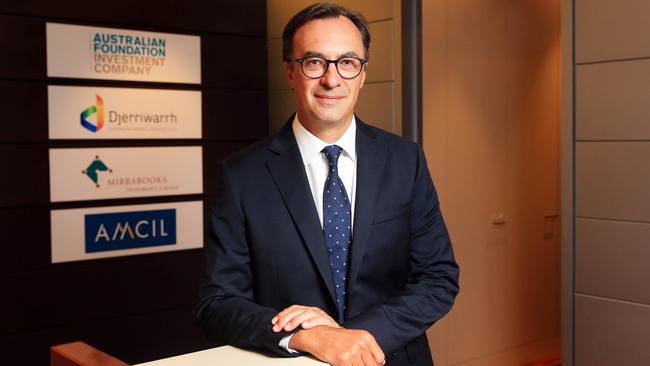Australian Foundation Investment Co eyes high-quality opportunities in bumpy earnings season
Australia’s largest listed investment company anticipates an uncertain earnings reporting season, presenting chances to invest in resilient companies with promising outlooks.

Australia’s largest listed investment company, the $9bn Australian Foundation Investment Co, expects a bumpy earnings reporting season that could bring opportunities to buy high-quality companies.
Speaking after posting a 14 per cent fall in 2023 profit following bumper dividend receipts last year, AFIC managing director Mark Freeman said companies had been resilient in navigating higher interest rates and inflation, but their outlooks would be the focus.
“I think the results will be OK, but if the outlook comments say things are slowing, I think that will probably move share prices,” he said.
A recovery in AFIC’s investment performance from the losses it posted last year helped it declare a 14 cent dividend, the same as last year, half of which will be funded with capital gains from its investments.
That was on top of the interim 11 cent dividend it paid in February that was 10 per cent higher than the previous year.
Net profit of $310m was down 14 per cent from last year’s bumper profit due to a special dividend from the merger of Woodside and BHP’s petroleum unit.
That $74.9 million payment last year had a significant impact, offsetting gains from higher dividends and portfolio movements this year. Excluding the dividend payment, full-year profit rose 8.6 per cent, it said.
The results are preliminary as they are in the process of being audited.
Including franking benefits from its portfolio of investments, the fund achieved an after-fee return of 13.9 per cent. That was below the S & P/ASX 200 Index‘ 16.6 per cent return (including franking), which benefited from a surge in technology shares associated with artificial intelligence hype.
Mr Freeman said the investment company’s holdings in banks, which were big sources of franked dividends, could be an area of opportunity. That was given if their outlooks deteriorated marginally in the current economic environment, because they still had very healthy capital structures and provided high dividend yields.
“We do think their bad debt charges will have to increase from here, but there‘s been a sell off in the sector in the past six months, particularly because of the issues with the regional banks in the US,” he said.
“That fear spread into the Australian market and has caused weakness in their share prices.”
“If we see further weakness, we would probably look again, because sometimes the market underestimates the value in their franking credits and the dividend.”
He added the fund would also look for opportunities to buy undervalued companies with good growth prospects.
The big banks – including CBA, NAB, Westpac, ANZ and Macquarie – account for 23 per cent of AFIC’s portfolio, or $2bn. Its position in NAB as of June 30 had increased 11.7 per cent during the year to $341m, while its exposure to CBA was also 9.6 per cent higher than a year earlier.
It also boosted investments in BHP, IDP Education, Domino’s Pizza and Santos.
Net tangible assets before dividends rose 4.2 per cent to $7.19 compared to the December 2022 valuation.
The fund also underperformed the benchmark in the three and ten-year investment horizons, but has matched its 8.6 per cent annual return over the five year period.
The underperformance of toll road operator Transurban, logistics company Mainfreight, and bourse operator ASX, dragged returns compared to the index in the 2023 financial year, as did its underweight position in material companies, other than BHP and Rio Tinto.
The fund trimmed positions in companies that were trading at “extreme valuations” it said, including in data centre provider NEXTDC, pallets and logistic giant Brambles, trading software provider IRESS, and Carsales.com, among others.
It exited its position in online retailer Temple & Webster and started buying shares in appliance maker Breville as it liked its growth prospects in offshore markets like the US and Europe.




To join the conversation, please log in. Don't have an account? Register
Join the conversation, you are commenting as Logout